Australia and New Zealand Banking Group: Company Accounting Memorandum
VerifiedAdded on 2022/10/06
|7
|1768
|94
Homework Assignment
AI Summary
This memorandum, prepared for the Board of Directors of the Australia and New Zealand Banking Group Limited (ANZ), details the technical aspects of financial consolidation. It explains the process of preparing consolidated financial statements, which include the parent company (ANZ) and its subsidiaries, emphasizing the importance of control and the elimination of inter-entity transactions. The memo highlights the company's commitment to corporate governance and sustainability, referencing the ASX Corporate Governance Council recommendations and the disclosures in the company's annual reports. It discusses the absence of goodwill on acquisitions in 2018, the risk of subsidiaries' transactions manipulation, and the assessment of impairment. The memorandum further addresses various risk factors, including cash flow projections, credit risk, and contingent liabilities, such as bank fees litigation and regulatory exposures. The author highlights the company's good solvency and liquidity positions, as well as the reduction in credit impairment provisions. Finally, the memorandum underscores the importance of accurate subsidiary financial statements to ensure the integrity of the consolidated financial statements. The document concludes by emphasizing the importance of the Group's commitment to corporate governance and sustainability.
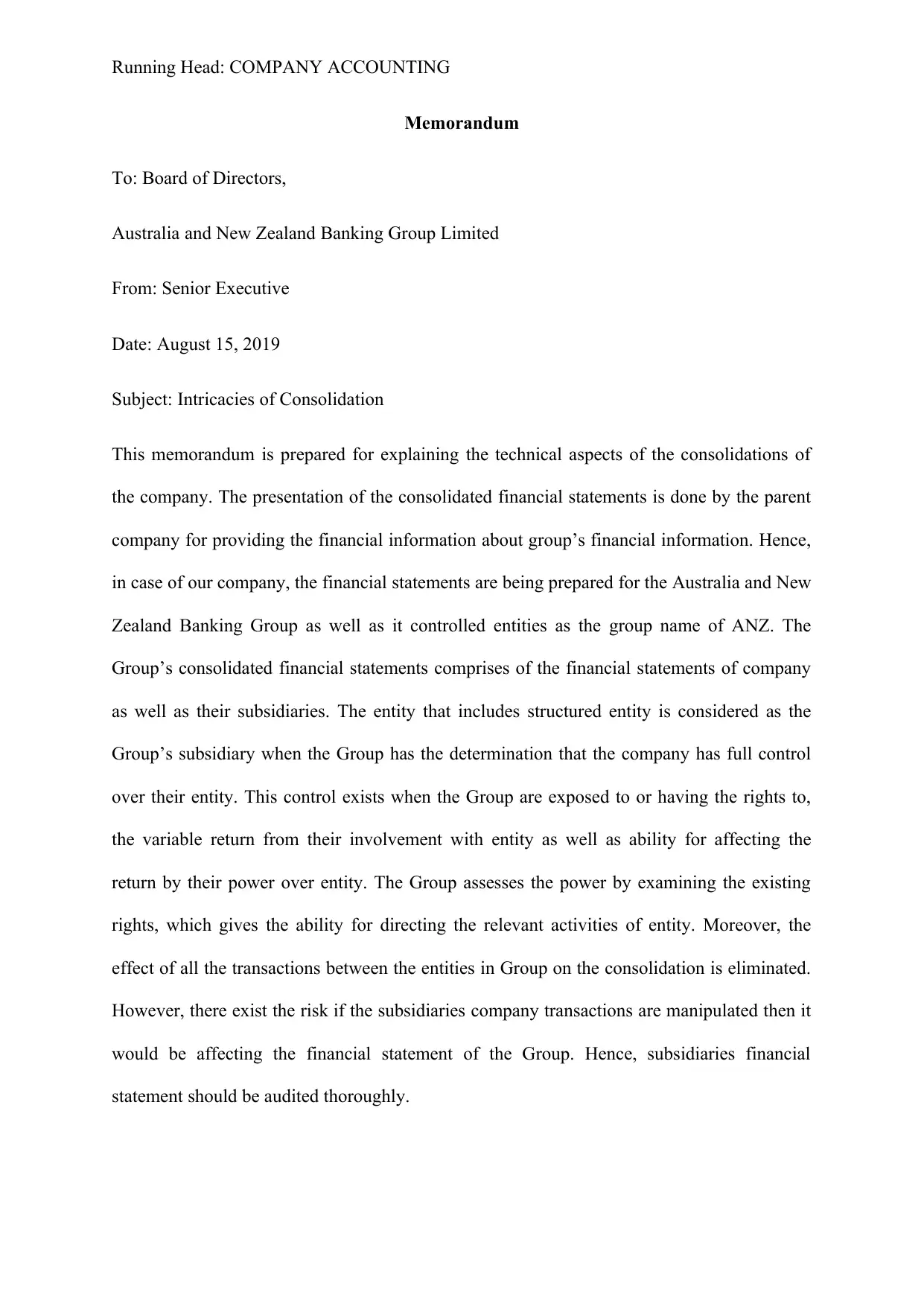
Running Head: COMPANY ACCOUNTING
Memorandum
To: Board of Directors,
Australia and New Zealand Banking Group Limited
From: Senior Executive
Date: August 15, 2019
Subject: Intricacies of Consolidation
This memorandum is prepared for explaining the technical aspects of the consolidations of
the company. The presentation of the consolidated financial statements is done by the parent
company for providing the financial information about group’s financial information. Hence,
in case of our company, the financial statements are being prepared for the Australia and New
Zealand Banking Group as well as it controlled entities as the group name of ANZ. The
Group’s consolidated financial statements comprises of the financial statements of company
as well as their subsidiaries. The entity that includes structured entity is considered as the
Group’s subsidiary when the Group has the determination that the company has full control
over their entity. This control exists when the Group are exposed to or having the rights to,
the variable return from their involvement with entity as well as ability for affecting the
return by their power over entity. The Group assesses the power by examining the existing
rights, which gives the ability for directing the relevant activities of entity. Moreover, the
effect of all the transactions between the entities in Group on the consolidation is eliminated.
However, there exist the risk if the subsidiaries company transactions are manipulated then it
would be affecting the financial statement of the Group. Hence, subsidiaries financial
statement should be audited thoroughly.
Memorandum
To: Board of Directors,
Australia and New Zealand Banking Group Limited
From: Senior Executive
Date: August 15, 2019
Subject: Intricacies of Consolidation
This memorandum is prepared for explaining the technical aspects of the consolidations of
the company. The presentation of the consolidated financial statements is done by the parent
company for providing the financial information about group’s financial information. Hence,
in case of our company, the financial statements are being prepared for the Australia and New
Zealand Banking Group as well as it controlled entities as the group name of ANZ. The
Group’s consolidated financial statements comprises of the financial statements of company
as well as their subsidiaries. The entity that includes structured entity is considered as the
Group’s subsidiary when the Group has the determination that the company has full control
over their entity. This control exists when the Group are exposed to or having the rights to,
the variable return from their involvement with entity as well as ability for affecting the
return by their power over entity. The Group assesses the power by examining the existing
rights, which gives the ability for directing the relevant activities of entity. Moreover, the
effect of all the transactions between the entities in Group on the consolidation is eliminated.
However, there exist the risk if the subsidiaries company transactions are manipulated then it
would be affecting the financial statement of the Group. Hence, subsidiaries financial
statement should be audited thoroughly.
Paraphrase This Document
Need a fresh take? Get an instant paraphrase of this document with our AI Paraphraser
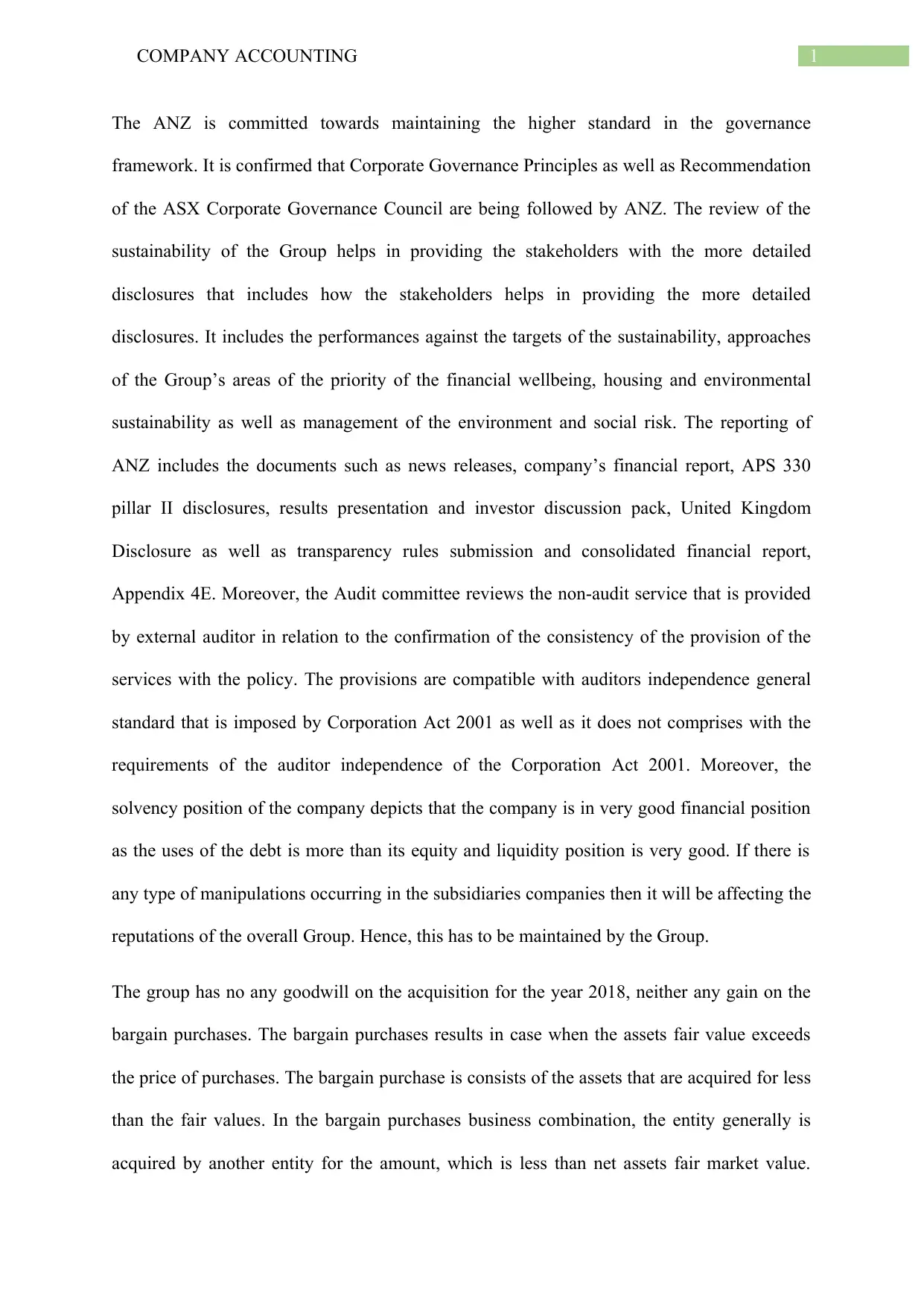
1COMPANY ACCOUNTING
The ANZ is committed towards maintaining the higher standard in the governance
framework. It is confirmed that Corporate Governance Principles as well as Recommendation
of the ASX Corporate Governance Council are being followed by ANZ. The review of the
sustainability of the Group helps in providing the stakeholders with the more detailed
disclosures that includes how the stakeholders helps in providing the more detailed
disclosures. It includes the performances against the targets of the sustainability, approaches
of the Group’s areas of the priority of the financial wellbeing, housing and environmental
sustainability as well as management of the environment and social risk. The reporting of
ANZ includes the documents such as news releases, company’s financial report, APS 330
pillar II disclosures, results presentation and investor discussion pack, United Kingdom
Disclosure as well as transparency rules submission and consolidated financial report,
Appendix 4E. Moreover, the Audit committee reviews the non-audit service that is provided
by external auditor in relation to the confirmation of the consistency of the provision of the
services with the policy. The provisions are compatible with auditors independence general
standard that is imposed by Corporation Act 2001 as well as it does not comprises with the
requirements of the auditor independence of the Corporation Act 2001. Moreover, the
solvency position of the company depicts that the company is in very good financial position
as the uses of the debt is more than its equity and liquidity position is very good. If there is
any type of manipulations occurring in the subsidiaries companies then it will be affecting the
reputations of the overall Group. Hence, this has to be maintained by the Group.
The group has no any goodwill on the acquisition for the year 2018, neither any gain on the
bargain purchases. The bargain purchases results in case when the assets fair value exceeds
the price of purchases. The bargain purchase is consists of the assets that are acquired for less
than the fair values. In the bargain purchases business combination, the entity generally is
acquired by another entity for the amount, which is less than net assets fair market value.
The ANZ is committed towards maintaining the higher standard in the governance
framework. It is confirmed that Corporate Governance Principles as well as Recommendation
of the ASX Corporate Governance Council are being followed by ANZ. The review of the
sustainability of the Group helps in providing the stakeholders with the more detailed
disclosures that includes how the stakeholders helps in providing the more detailed
disclosures. It includes the performances against the targets of the sustainability, approaches
of the Group’s areas of the priority of the financial wellbeing, housing and environmental
sustainability as well as management of the environment and social risk. The reporting of
ANZ includes the documents such as news releases, company’s financial report, APS 330
pillar II disclosures, results presentation and investor discussion pack, United Kingdom
Disclosure as well as transparency rules submission and consolidated financial report,
Appendix 4E. Moreover, the Audit committee reviews the non-audit service that is provided
by external auditor in relation to the confirmation of the consistency of the provision of the
services with the policy. The provisions are compatible with auditors independence general
standard that is imposed by Corporation Act 2001 as well as it does not comprises with the
requirements of the auditor independence of the Corporation Act 2001. Moreover, the
solvency position of the company depicts that the company is in very good financial position
as the uses of the debt is more than its equity and liquidity position is very good. If there is
any type of manipulations occurring in the subsidiaries companies then it will be affecting the
reputations of the overall Group. Hence, this has to be maintained by the Group.
The group has no any goodwill on the acquisition for the year 2018, neither any gain on the
bargain purchases. The bargain purchases results in case when the assets fair value exceeds
the price of purchases. The bargain purchase is consists of the assets that are acquired for less
than the fair values. In the bargain purchases business combination, the entity generally is
acquired by another entity for the amount, which is less than net assets fair market value.
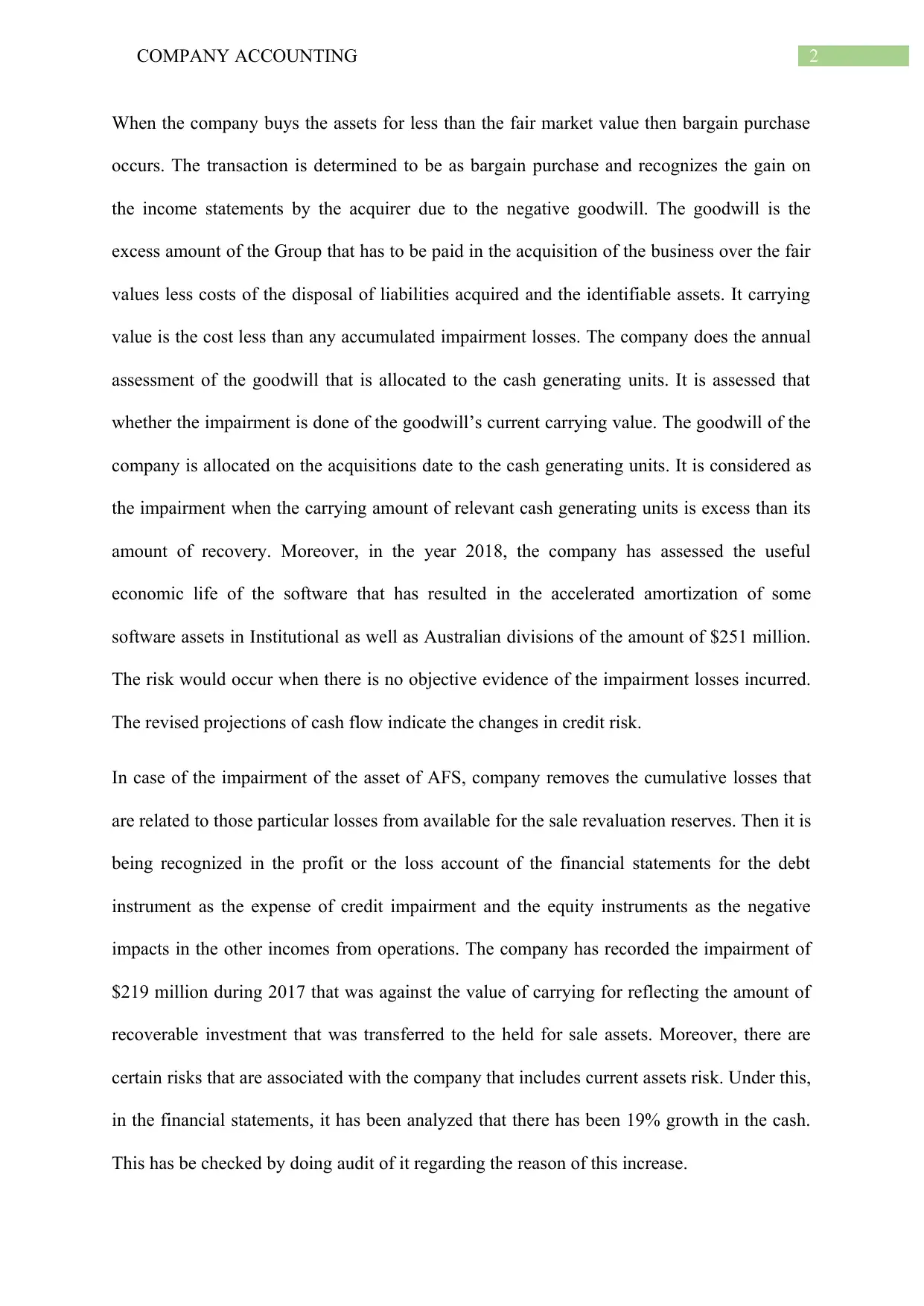
2COMPANY ACCOUNTING
When the company buys the assets for less than the fair market value then bargain purchase
occurs. The transaction is determined to be as bargain purchase and recognizes the gain on
the income statements by the acquirer due to the negative goodwill. The goodwill is the
excess amount of the Group that has to be paid in the acquisition of the business over the fair
values less costs of the disposal of liabilities acquired and the identifiable assets. It carrying
value is the cost less than any accumulated impairment losses. The company does the annual
assessment of the goodwill that is allocated to the cash generating units. It is assessed that
whether the impairment is done of the goodwill’s current carrying value. The goodwill of the
company is allocated on the acquisitions date to the cash generating units. It is considered as
the impairment when the carrying amount of relevant cash generating units is excess than its
amount of recovery. Moreover, in the year 2018, the company has assessed the useful
economic life of the software that has resulted in the accelerated amortization of some
software assets in Institutional as well as Australian divisions of the amount of $251 million.
The risk would occur when there is no objective evidence of the impairment losses incurred.
The revised projections of cash flow indicate the changes in credit risk.
In case of the impairment of the asset of AFS, company removes the cumulative losses that
are related to those particular losses from available for the sale revaluation reserves. Then it is
being recognized in the profit or the loss account of the financial statements for the debt
instrument as the expense of credit impairment and the equity instruments as the negative
impacts in the other incomes from operations. The company has recorded the impairment of
$219 million during 2017 that was against the value of carrying for reflecting the amount of
recoverable investment that was transferred to the held for sale assets. Moreover, there are
certain risks that are associated with the company that includes current assets risk. Under this,
in the financial statements, it has been analyzed that there has been 19% growth in the cash.
This has be checked by doing audit of it regarding the reason of this increase.
When the company buys the assets for less than the fair market value then bargain purchase
occurs. The transaction is determined to be as bargain purchase and recognizes the gain on
the income statements by the acquirer due to the negative goodwill. The goodwill is the
excess amount of the Group that has to be paid in the acquisition of the business over the fair
values less costs of the disposal of liabilities acquired and the identifiable assets. It carrying
value is the cost less than any accumulated impairment losses. The company does the annual
assessment of the goodwill that is allocated to the cash generating units. It is assessed that
whether the impairment is done of the goodwill’s current carrying value. The goodwill of the
company is allocated on the acquisitions date to the cash generating units. It is considered as
the impairment when the carrying amount of relevant cash generating units is excess than its
amount of recovery. Moreover, in the year 2018, the company has assessed the useful
economic life of the software that has resulted in the accelerated amortization of some
software assets in Institutional as well as Australian divisions of the amount of $251 million.
The risk would occur when there is no objective evidence of the impairment losses incurred.
The revised projections of cash flow indicate the changes in credit risk.
In case of the impairment of the asset of AFS, company removes the cumulative losses that
are related to those particular losses from available for the sale revaluation reserves. Then it is
being recognized in the profit or the loss account of the financial statements for the debt
instrument as the expense of credit impairment and the equity instruments as the negative
impacts in the other incomes from operations. The company has recorded the impairment of
$219 million during 2017 that was against the value of carrying for reflecting the amount of
recoverable investment that was transferred to the held for sale assets. Moreover, there are
certain risks that are associated with the company that includes current assets risk. Under this,
in the financial statements, it has been analyzed that there has been 19% growth in the cash.
This has be checked by doing audit of it regarding the reason of this increase.
⊘ This is a preview!⊘
Do you want full access?
Subscribe today to unlock all pages.

Trusted by 1+ million students worldwide
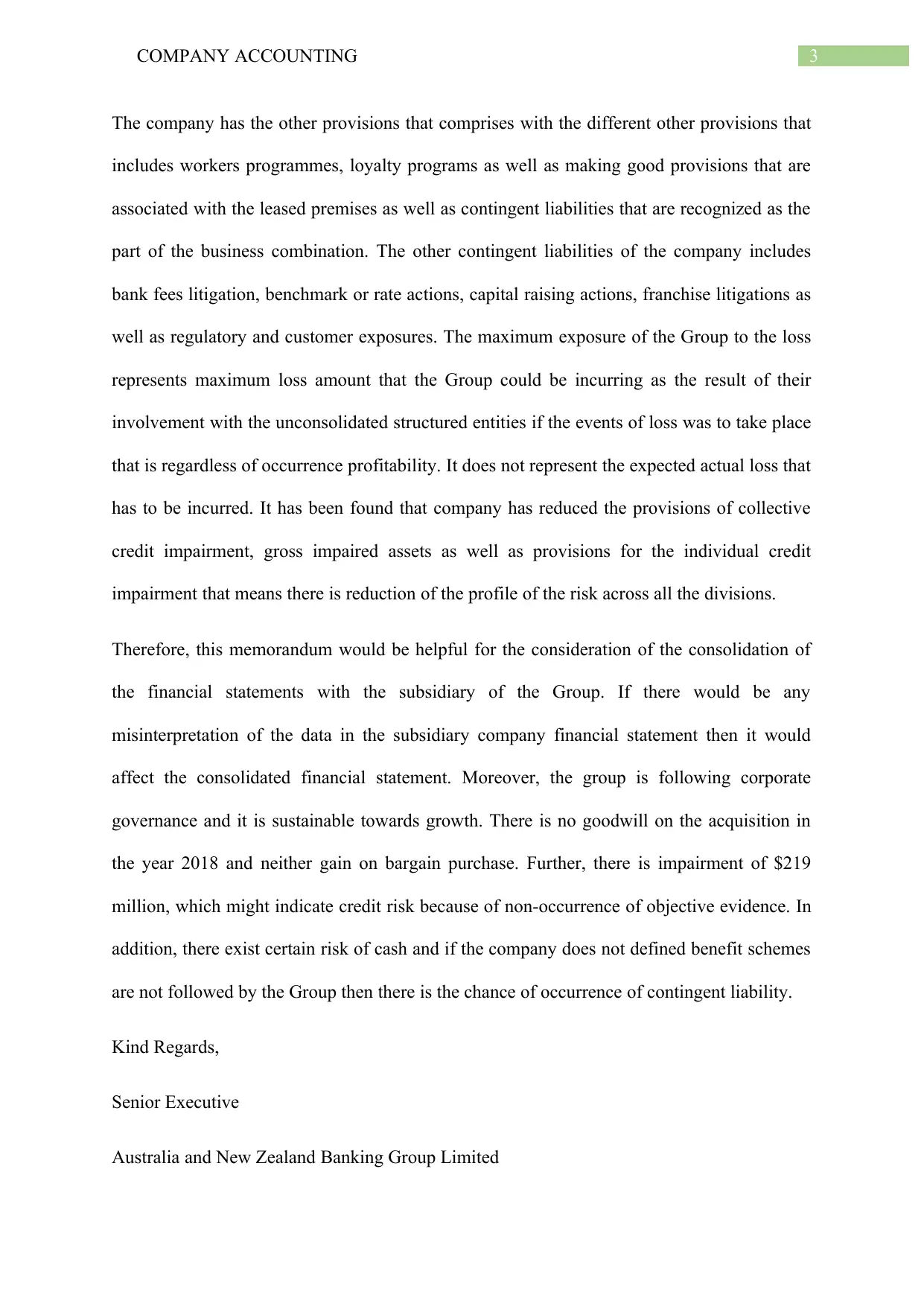
3COMPANY ACCOUNTING
The company has the other provisions that comprises with the different other provisions that
includes workers programmes, loyalty programs as well as making good provisions that are
associated with the leased premises as well as contingent liabilities that are recognized as the
part of the business combination. The other contingent liabilities of the company includes
bank fees litigation, benchmark or rate actions, capital raising actions, franchise litigations as
well as regulatory and customer exposures. The maximum exposure of the Group to the loss
represents maximum loss amount that the Group could be incurring as the result of their
involvement with the unconsolidated structured entities if the events of loss was to take place
that is regardless of occurrence profitability. It does not represent the expected actual loss that
has to be incurred. It has been found that company has reduced the provisions of collective
credit impairment, gross impaired assets as well as provisions for the individual credit
impairment that means there is reduction of the profile of the risk across all the divisions.
Therefore, this memorandum would be helpful for the consideration of the consolidation of
the financial statements with the subsidiary of the Group. If there would be any
misinterpretation of the data in the subsidiary company financial statement then it would
affect the consolidated financial statement. Moreover, the group is following corporate
governance and it is sustainable towards growth. There is no goodwill on the acquisition in
the year 2018 and neither gain on bargain purchase. Further, there is impairment of $219
million, which might indicate credit risk because of non-occurrence of objective evidence. In
addition, there exist certain risk of cash and if the company does not defined benefit schemes
are not followed by the Group then there is the chance of occurrence of contingent liability.
Kind Regards,
Senior Executive
Australia and New Zealand Banking Group Limited
The company has the other provisions that comprises with the different other provisions that
includes workers programmes, loyalty programs as well as making good provisions that are
associated with the leased premises as well as contingent liabilities that are recognized as the
part of the business combination. The other contingent liabilities of the company includes
bank fees litigation, benchmark or rate actions, capital raising actions, franchise litigations as
well as regulatory and customer exposures. The maximum exposure of the Group to the loss
represents maximum loss amount that the Group could be incurring as the result of their
involvement with the unconsolidated structured entities if the events of loss was to take place
that is regardless of occurrence profitability. It does not represent the expected actual loss that
has to be incurred. It has been found that company has reduced the provisions of collective
credit impairment, gross impaired assets as well as provisions for the individual credit
impairment that means there is reduction of the profile of the risk across all the divisions.
Therefore, this memorandum would be helpful for the consideration of the consolidation of
the financial statements with the subsidiary of the Group. If there would be any
misinterpretation of the data in the subsidiary company financial statement then it would
affect the consolidated financial statement. Moreover, the group is following corporate
governance and it is sustainable towards growth. There is no goodwill on the acquisition in
the year 2018 and neither gain on bargain purchase. Further, there is impairment of $219
million, which might indicate credit risk because of non-occurrence of objective evidence. In
addition, there exist certain risk of cash and if the company does not defined benefit schemes
are not followed by the Group then there is the chance of occurrence of contingent liability.
Kind Regards,
Senior Executive
Australia and New Zealand Banking Group Limited
Paraphrase This Document
Need a fresh take? Get an instant paraphrase of this document with our AI Paraphraser

4COMPANY ACCOUNTING
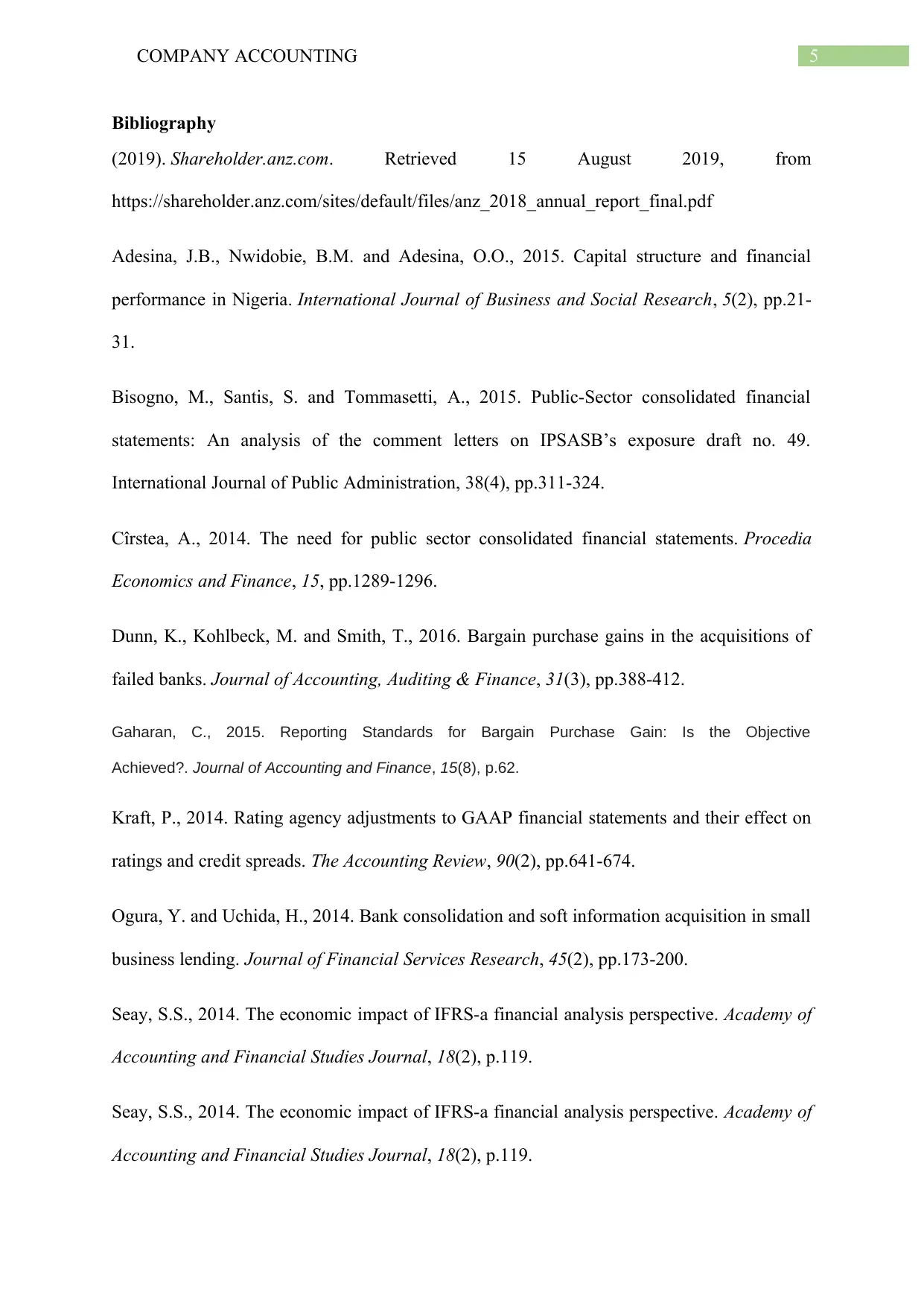
5COMPANY ACCOUNTING
Bibliography
(2019). Shareholder.anz.com. Retrieved 15 August 2019, from
https://shareholder.anz.com/sites/default/files/anz_2018_annual_report_final.pdf
Adesina, J.B., Nwidobie, B.M. and Adesina, O.O., 2015. Capital structure and financial
performance in Nigeria. International Journal of Business and Social Research, 5(2), pp.21-
31.
Bisogno, M., Santis, S. and Tommasetti, A., 2015. Public-Sector consolidated financial
statements: An analysis of the comment letters on IPSASB’s exposure draft no. 49.
International Journal of Public Administration, 38(4), pp.311-324.
Cîrstea, A., 2014. The need for public sector consolidated financial statements. Procedia
Economics and Finance, 15, pp.1289-1296.
Dunn, K., Kohlbeck, M. and Smith, T., 2016. Bargain purchase gains in the acquisitions of
failed banks. Journal of Accounting, Auditing & Finance, 31(3), pp.388-412.
Gaharan, C., 2015. Reporting Standards for Bargain Purchase Gain: Is the Objective
Achieved?. Journal of Accounting and Finance, 15(8), p.62.
Kraft, P., 2014. Rating agency adjustments to GAAP financial statements and their effect on
ratings and credit spreads. The Accounting Review, 90(2), pp.641-674.
Ogura, Y. and Uchida, H., 2014. Bank consolidation and soft information acquisition in small
business lending. Journal of Financial Services Research, 45(2), pp.173-200.
Seay, S.S., 2014. The economic impact of IFRS-a financial analysis perspective. Academy of
Accounting and Financial Studies Journal, 18(2), p.119.
Seay, S.S., 2014. The economic impact of IFRS-a financial analysis perspective. Academy of
Accounting and Financial Studies Journal, 18(2), p.119.
Bibliography
(2019). Shareholder.anz.com. Retrieved 15 August 2019, from
https://shareholder.anz.com/sites/default/files/anz_2018_annual_report_final.pdf
Adesina, J.B., Nwidobie, B.M. and Adesina, O.O., 2015. Capital structure and financial
performance in Nigeria. International Journal of Business and Social Research, 5(2), pp.21-
31.
Bisogno, M., Santis, S. and Tommasetti, A., 2015. Public-Sector consolidated financial
statements: An analysis of the comment letters on IPSASB’s exposure draft no. 49.
International Journal of Public Administration, 38(4), pp.311-324.
Cîrstea, A., 2014. The need for public sector consolidated financial statements. Procedia
Economics and Finance, 15, pp.1289-1296.
Dunn, K., Kohlbeck, M. and Smith, T., 2016. Bargain purchase gains in the acquisitions of
failed banks. Journal of Accounting, Auditing & Finance, 31(3), pp.388-412.
Gaharan, C., 2015. Reporting Standards for Bargain Purchase Gain: Is the Objective
Achieved?. Journal of Accounting and Finance, 15(8), p.62.
Kraft, P., 2014. Rating agency adjustments to GAAP financial statements and their effect on
ratings and credit spreads. The Accounting Review, 90(2), pp.641-674.
Ogura, Y. and Uchida, H., 2014. Bank consolidation and soft information acquisition in small
business lending. Journal of Financial Services Research, 45(2), pp.173-200.
Seay, S.S., 2014. The economic impact of IFRS-a financial analysis perspective. Academy of
Accounting and Financial Studies Journal, 18(2), p.119.
Seay, S.S., 2014. The economic impact of IFRS-a financial analysis perspective. Academy of
Accounting and Financial Studies Journal, 18(2), p.119.
⊘ This is a preview!⊘
Do you want full access?
Subscribe today to unlock all pages.

Trusted by 1+ million students worldwide
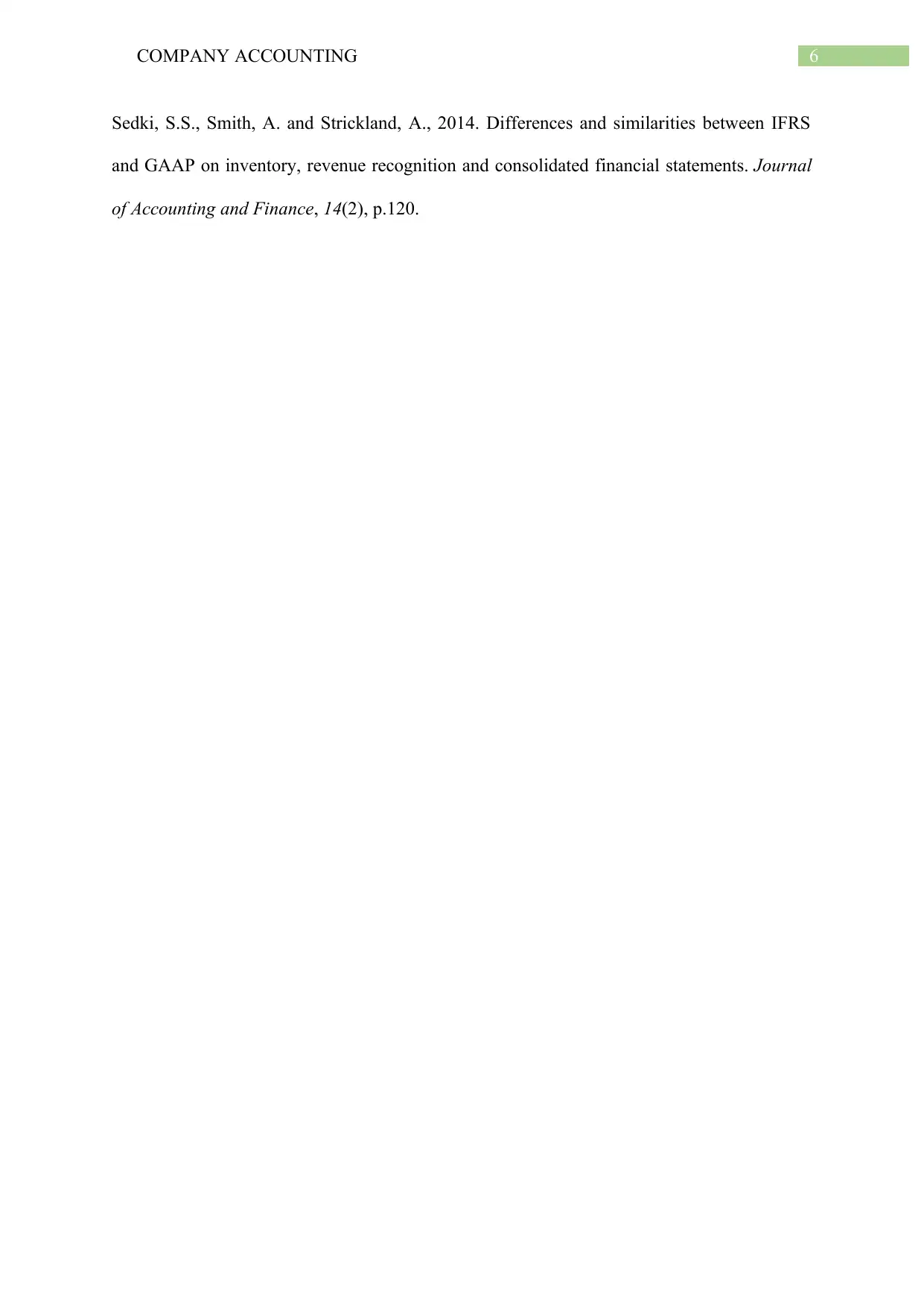
6COMPANY ACCOUNTING
Sedki, S.S., Smith, A. and Strickland, A., 2014. Differences and similarities between IFRS
and GAAP on inventory, revenue recognition and consolidated financial statements. Journal
of Accounting and Finance, 14(2), p.120.
Sedki, S.S., Smith, A. and Strickland, A., 2014. Differences and similarities between IFRS
and GAAP on inventory, revenue recognition and consolidated financial statements. Journal
of Accounting and Finance, 14(2), p.120.
1 out of 7
Related Documents
Your All-in-One AI-Powered Toolkit for Academic Success.
+13062052269
info@desklib.com
Available 24*7 on WhatsApp / Email
![[object Object]](/_next/static/media/star-bottom.7253800d.svg)
Unlock your academic potential
Copyright © 2020–2025 A2Z Services. All Rights Reserved. Developed and managed by ZUCOL.




